The Intel SSD 540s (480GB) Review
by Billy Tallis on June 23, 2016 9:00 AM ESTATTO
ATTO's Disk Benchmark is a quick and easy freeware tool to measure drive performance across various transfer sizes.
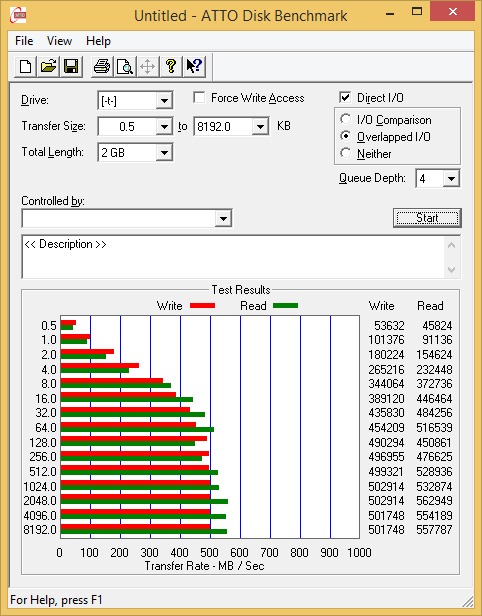 |
|||||||||
The Intel 540s's performance is a bit uneven during the ATTO benchmark, but its write speed advantage over the SP550 is still quite clear.
AS-SSD
AS-SSD is another quick and free benchmark tool. It uses incompressible data for all of its tests, making it an easy way to keep an eye on which drives are relying on transparent data compression. The short duration of the test makes it a decent indicator of peak drive performance.
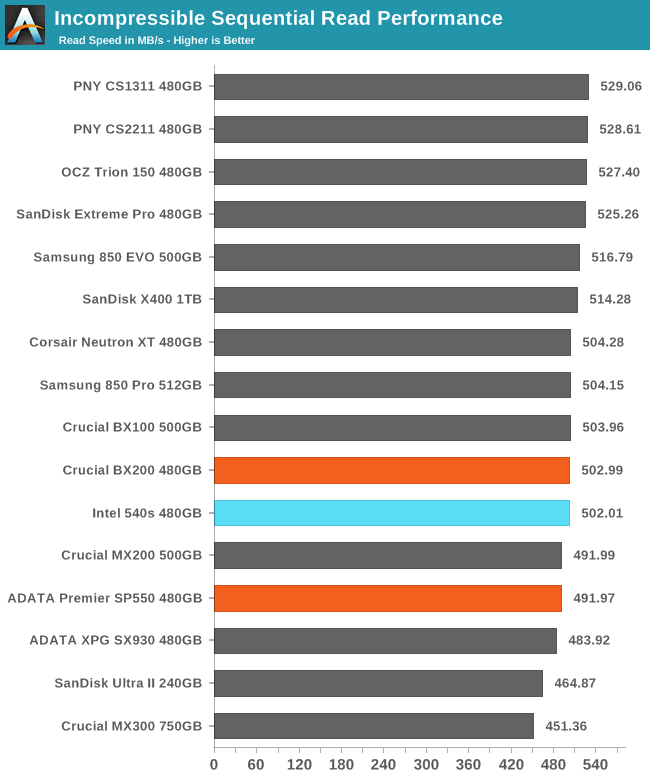
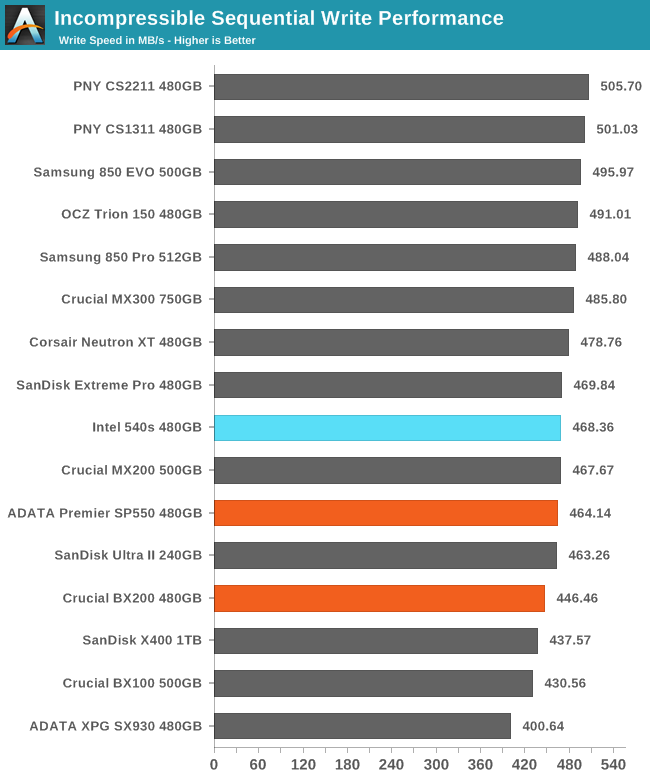
The AS-SSD test does very little to differentiate between drives, but it at least shows that the Intel 540s can reach similar peak speeds to its competition.
Idle Power Consumption
Since the ATSB tests based on real-world usage cut idle times short to 25ms, their power consumption scores paint an inaccurate picture of the relative suitability of drives for mobile use. During real-world client use, a solid state drive will spend far more time idle than actively processing commands. Our testbed doesn't support the deepest DevSlp power saving mode that SATA drives can implement, but we can measure the power usage in the intermediate slumber state where both the host and device ends of the SATA link enter a low-power state and the drive is free to engage its internal power savings measures.
We also report the drive's idle power consumption while the SATA link is active and not in any power saving state. Drives are required to be able to wake from the slumber state in under 10 milliseconds, but that still leaves plenty of room for them to add latency to a burst of I/O. Because of this, many desktops default to either not using SATA Aggressive Link Power Management (ALPM) at all or to only enable it partially without making use of the device-initiated power management (DIPM) capability. Additionally, SATA Hot-Swap is incompatible with the use of DIPM, so our SSD testbed usually has DIPM turned off during performance testing.
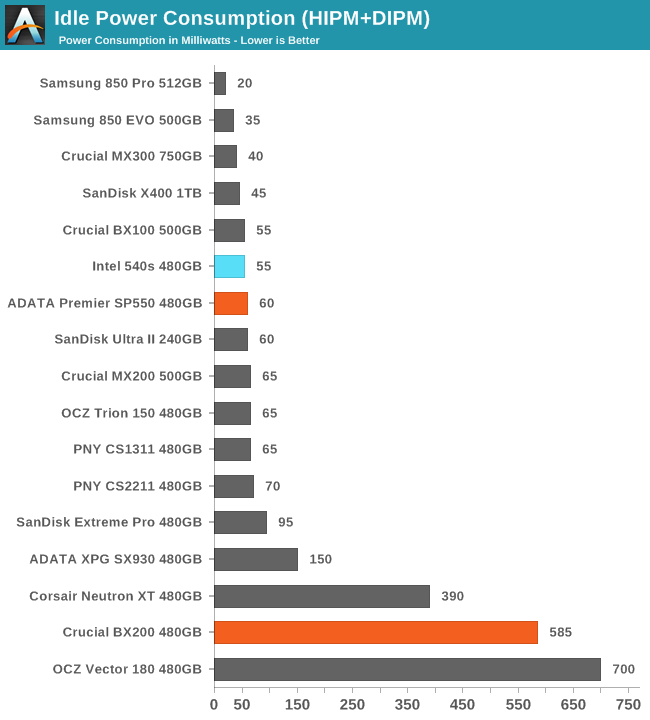
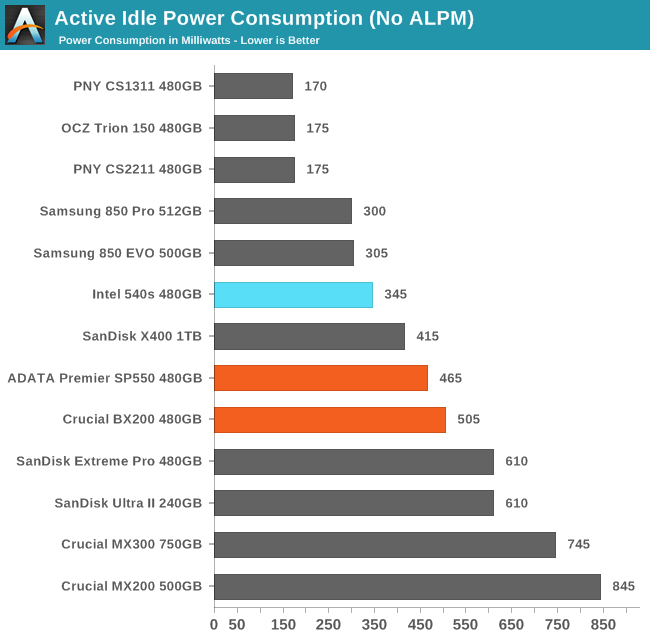
The slumber power state is working correctly on the Intel 540s and allows for very slightly lower idle power draw than the SP550. Active idle power is significantly improved over the SM2256 and is now behind only Samsung and Phison controllers. Silicon Motion's 40nm SM2258 clearly beats Marvell's 28nm 88SS1074 used in the SanDisk X400 and Crucial MX300.










77 Comments
View All Comments
Notmyusualid - Thursday, June 23, 2016 - link
Ya saved me from writing it...shelbystripes - Thursday, June 23, 2016 - link
Intel is considered a reliable brand to OEM PC makers and other bulk purchasers. Offering a low-end part means capturing business that might go to a second-tier manufacturer. For builders with a use case where any modern SSD is fast enough, and you care about reliability without breaking the bank, this will be the #1 choice. You get the Intel name and the things INCLUDED with that, like solid customer support and timely firmware updates, at a lower price point.Nobody buying this is expecting it to be a performance part. Intel is the company that sold Celerons with no L2 cache, that sells cut-down Atom CPUs and Core CPUs under the same Pentium brand name. Intel doesn't always mean performance. It does mean confidence that what you're buying actually works, though.
BurntMyBacon - Friday, June 24, 2016 - link
@shelbystripes: "Offering a low-end part means capturing business that might go to a second-tier manufacturer. For builders with a use case where any modern SSD is fast enough, and you care about reliability without breaking the bank, this will be the #1 choice."You know, Intel used to cater to this market, ... , with their 300 series drives. Interestingly, the relative performance of this drive matches up to where their 300 series used to slot in as well. Why is this not a 300 series drive?
vladx - Friday, June 24, 2016 - link
My tablet running an Atom quad-core works great. To compare this joke of a SSD from Intel to that is a fucking joke.plopke - Thursday, June 23, 2016 - link
Won't the 540 be shortlived? Shouldn't we be seeing 3d nand drives of intel soon followed by optane?https://i0.wp.com/benchlife.info/wp-content/upload...
A5 - Thursday, June 23, 2016 - link
This is for a different market segment.Billy Tallis - Thursday, June 23, 2016 - link
That roadmap shows the 540s sticking around at least through Q1 2017, and merely being joined by some Optane and 3D TLC NVMe drives. The actual replacement of the 540s is at an indefinite point in the future.The determining factor will be how long it takes 3D NAND to get cheap enough to displace 15/16nm TLC. I don't think that will be happening any time soon; even Samsung apparently can't pull it off yet, since they introduced the 750 EVO.
Mobile-Dom - Thursday, June 23, 2016 - link
IIRC Samsung used planar NAND in the 750 because they wanted lower capacity without the performance degradation, as by using the high layered 3D NAND they used fewer packages resulting in worse performance for drives that had 1 or 2 packages for the entire SSDextide - Thursday, June 23, 2016 - link
Nah, both their planar 15/16nm and their 3D NAND use 128Gb dies -- so same amount of dies in either product. It's purely a cost thing. It will probably take until we get into the 100+ layers of 3D NAND for it to be competitive, cost wise, with that 15/16nm planar TLC.Billy Tallis - Thursday, June 23, 2016 - link
That's what they said at first, but then they introduced a 500GB 750 EVO while the 850 EVOs on the market are still using the 32-layer VNAND.